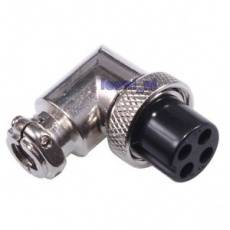Microphone Connector
Microphones play an essential role in the world of sound recording. Today, more and more of us are involved in video-based content production and streaming. But to do this, you need the right technology, a computer or laptop, a microphone and, of course, the right connectors. But we also connect microphones to amplifiers, mixing consoles and speakers. Read more...
• 4 pin female line microphone connector
• 5 pin female line microphone connector
• 5 pin male microphone connector
• 6 pin femple line microphone connector
• 6 Pin Male Chassis Mount Microphone Connector
• 6-pin microphone socket
Why do we need microphones? Because they turn sound waves into electrical signals, allowing us to record sound and then amplify and transmit it. There are different types of microphones, almost all with individual characteristics, but their connection is not unique but based on standards. Therefore, to connect a microphone effectively, the right connection interface is needed. This is usually achieved with a Jack and USB connector or XLR socket, which also provide power for some microphones.
.
What types of microphone connectors exist, and how to choose the right one for your needs
.
Remember that most microphones already have XLR connectors. This group includes hand-held microphones, directional microphones, studio microphones, broadcast microphones, etc. XLR plugs are cylindrical in design with three or more poles and are often used for sound recording, lighting, and low-voltage power. The 3-pole version is used to connect a condenser microphone.
The 4-pin XLR connector can be used for microphone headphones or microphones with LED indicators. The 5 and 6-pin XLR sockets are mostly used for stereo microphones. The 7-pin XLR socket is used to feed tube microphones, and the 8-pin sockets are used for the microphones of the transceivers. Remember, microphones with XLR connectors always need an audio interface, for example for digital recording of music.
The other connector is USB, which acts as an external analogue-to-digital converter. USB microphones can therefore be connected directly to a computer or other devices. The third type of connector we encounter with microphones is the Jack plug. The Jack socket and the XLR plug differ only in the type of output and the cable required.
How compatible is the microphone with other devices?
Microphones are generally designed to be compatible with other devices that are used to record or amplify sound. But they should also be easy to attach to a microphone stand, for example. Therefore, a mounting adapter is essential for most of them.
For studio recordings or live performances, which microphone connectors should be used?
For these types of jobs, we usually use two types of microphones. The condenser and the dynamic microphone. A condenser is a transducer principle microphone that works on the physical principle of a capacitor. In this case, the sound is converted into an electrical signal. This is the distance between the moving diaphragm and the counter electrode, which varies depending on the strength of the sound pressure. In this case, we usually use a USB A connector.
In contrast, a dynamic microphone works on the principle of electromagnetic induction. The speed at which the diaphragm moves transmits the signal. This type of microphone is mainly used to transmit the human voice, but it is also a suitable choice for transmitting the sound of musical instruments. With dynamic microphones, the recorded sound is more natural sounding than when using condenser microphones. When using dynamic microphones, you will need an XLR dome connector.
How can we maintain and clean the microphone connectors?
Dirt on the connectors at the end of the microphone cable can be easily removed. To do this, apply a small amount of isopropyl alcohol to a small piece of cloth, wipe the metal part of the connector with it and then clean it with a clean cloth. After cleaning and drying, reconnect the microphone and you are ready to test. With this small but very useful operation, your microphone will retain its sound quality for a long time.
To get the best sound, the connector is an essential element. Take a look at our range of microphone connectors.











